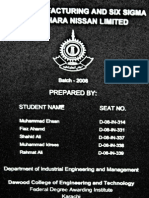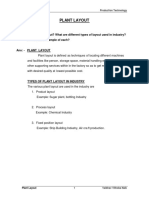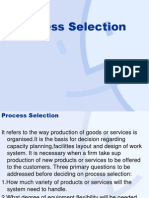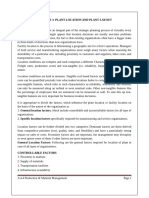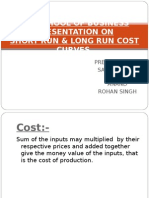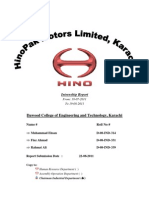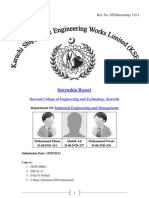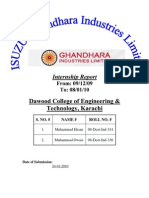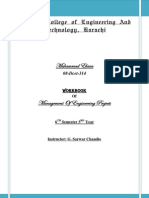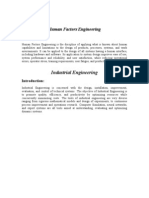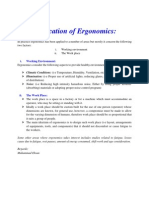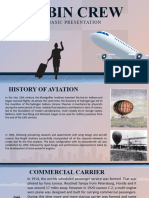Plant Location, Its Selection Criteria, and Factors Affecting Plant Location
Plant Location, Its Selection Criteria, and Factors Affecting Plant Location
Uploaded by
Engr Muhammad EhsanCopyright:
Available Formats
Plant Location, Its Selection Criteria, and Factors Affecting Plant Location
Plant Location, Its Selection Criteria, and Factors Affecting Plant Location
Uploaded by
Engr Muhammad EhsanOriginal Description:
Original Title
Copyright
Available Formats
Share this document
Did you find this document useful?
Is this content inappropriate?
Copyright:
Available Formats
Plant Location, Its Selection Criteria, and Factors Affecting Plant Location
Plant Location, Its Selection Criteria, and Factors Affecting Plant Location
Uploaded by
Engr Muhammad EhsanCopyright:
Available Formats
DAWOOD COLLEGE OF ENGINEERING AND TECHNOLOGY KARACHI
Department: Industrial Engineering and Management
MUHAMMAD EHSAN (08-Dcet-314)
Production Planning and Control Assignment No # 2
Submitted To: Engr. Imran Khan Shaikh Date # 12-10-2010
Production Planning and Control
PLANT LOCATION:
Every entrepreneur is faced with the problem of deciding the best site for location of his plant or factory. What is plant location? Plant location refers to the choice of region and the selection of a particular site for setting up a business or factory. But the choice is made only after considering cost and benefits of different alternative sites. It is a strategic decision that cannot be changed once taken. If at all changed only at considerable loss, the location should be selected as per its own requirements and circumstances. Each individual plant is a case in itself. Businessman should try to make an attempt for optimum or ideal location. What is an ideal location? An ideal location is one where the cost of the product is kept to minimum, with a large market share, the least risk and the maximum social gain. It is the place of maximum net advantage or which gives lowest unit cost of production and distribution. For achieving this objective, smallscale entrepreneur can make use of locational analysis for this purpose.
LOCATIONAL ANALYSIS:
Locational analysis is a dynamic process where entrepreneur analyses and compares the appropriateness or otherwise of alternative sites with the aim of selecting the best site for a given enterprise. It consists the following: Demographic Analysis: It involves study of population in the area in terms of total population (in no.), age composition, per capita income, educational level, occupational structure etc. Trade Area Analysis: It is an analysis of the geographic area that provides continued clientele to the firm. He would also see the feasibility of accessing the trade area from alternative sites. Competitive Analysis: It helps to judge the nature, location, size and quality of competition in a given trade area. Traffic analysis: To have a rough idea about the number of potential customers passing by the proposed site during the working hours of the shop, the traffic analysis aims at judging the alternative sites in terms of pedestrian and vehicular traffic passing a site. Site economics: Alternative sites are evaluated in terms of establishment costs and operational costs under this. Costs of establishment is basically cost incurred for permanent physical facilities but operational costs are incurred for running business on day to day basis, they are also called as running costs. M Ehsan
-2-
08-Dcet-314
Production Planning and Control
SELECTION CRITERIA:
The important considerations for selecting a suitable location are given as follows: Natural or climatic conditions. Availability and nearness to the sources of raw material. Transport costs-in obtaining raw material and also distribution or marketing finished products to the ultimate users. Access to market: small businesses in retail or wholesale or services should be located within the vicinity of densely populated areas. Availability of Infrastructural facilities such as developed industrial sheds or sites, link roads, nearness to railway stations, airports or sea ports, availability of electricity, water, public utilities, civil amenities and means of communication are important, especially for small scale businesses. Availability of skilled and non-skilled labour and technically qualified and trained managers. Banking and financial institutions are located nearby. Locations with links: to develop industrial areas or business centers result in savings and cost reductions in transport overheads, miscellaneous expenses. Strategic considerations of safety and security should be given due importance. Government influences: Both positive and negative incentives to motivate an entrepreneur to choose a particular location are made available. Positive includes cheap overhead facilities like electricity, banking transport, tax relief, subsidies and liberalization. Negative incentives are in form of restrictions for setting up industries in urban areas for reasons of pollution control and decentralization of industries. Residence of small business entrepreneurs want to set up nearby their homelands. One study of locational considerations from small-scale units revealed that the native place or homelands of the entrepreneur was the most important factor. Heavy preference to homeland suggests that small-scale enterprise is not freely mobile. Low preference for Government incentives suggests that concessions and incentives cannot compensate for poor infrastructure.
M Ehsan
-3-
08-Dcet-314
Production Planning and Control
Factors Affecting Plant Location:
The task of finding a perfect or ideal location for a plant is very much difficult, and it has been observed that hardly any location can be ideal or perfect. But still following are some of the factors, which should be kept in mind while selection for a plant: 1) Raw Material Availability: Raw material should be easily available near to a selected location, as it will reduce the cost of transporting raw materials. 2) Nearness to Markets: it will reduce the cost of transporting the finished goods to the market but also decrease the chances of finished product being damaged or spoiled in the way. Moreover a plant being near to the market can catch a big share of the market and can also provide quick service to the customers. 3) Transportation Cost and Facilities: A lot of many is spent both in transporting raw materials and finished goods, therefore it should also be kept in mind that the transportation cost should be fairly minimum and also be available easily. 4) Labor Availability, Cost and Unions: Labor should be easily available of right kind, and adequate size with proper attitude towards work. 5) Fuel and Power Availability: Fuel (Coal, Oil, etc) and Power (Electricity) are the main factors for the running of a plant; therefore it should be available easily and nearer to plant. It is essential that the electricity should be remain available continuously 24/7, in proper quantity and at reasonable rates. 6) Availability of Water: After Fuel and Power the next important thing is the availability of water resources, as water is used for many purposes i-e for processing in paper and chemical industries and also for domestic use like drinking and sanitary purposes. 7) Climate Conditions: With the development in the field of heating, ventilating and airconditioning, climate of the region does not have much problem. But still it is of much importance to select a location having normal climatic conditions because it is very much difficult and in some cases almost impossible to control the climatic conditions (i-e heat, ventilation, etc) in all part of the plant. 8) Financial and Other Aids: In some state local government provide various facilities (ie provide loans, feed money in business, machinery, relaxation in tax policy, excise duties, etc) to attract industrialists. It is also important to have knowledge about government regulations and if are available should be made use of the facilities. 9) Availability of Land: The characteristics of the land at the proposed plant site should be examined carefully. The cost of the land is important, as well as local building costs and living conditions. Future changes may make it desirable or necessary to expand the plant facilities. The land should be ideally flat, well drained and have load-bearing characteristics
M Ehsan
-4-
08-Dcet-314
Production Planning and Control
10) Topography of Land (i.e. basic characteristic of land): It is very much important to have knowledge about the area, shape of the site, drainage, earthquakes, floods etc of the land being selected for the plant. One can get this sort of knowledge form the past history of the area. 11) Community Attitude: Success of an industry mainly depend on the attitude of the local people that whether the people there are educated or not, and or willing to do work or not, and the most important of them all is whether the society has any extremist factor or not. 12) Construction Cost: It is also very important to have close view about the construction cost before setting-up an industry. 13) Environmental Regulations: Also try to have knowledge about the environmental regulations like the local policy regarding the environmental pollution, etc. 14) Local Community Consideration: The proposed plant must fit in with and be acceptable to the local community. Full consideration must be given to the safe location of the plant so that it does not impose a significant additional risk to the community. In addition to all these factors, if a company tries to locate an industry beyond national borders, then they have to consider following factors as well:
1) Culture 3) Exchange rates 5) Available technology
2) Government stability 4) Export and import regulations 6) Political and Economic systems
M Ehsan
-5-
08-Dcet-314
You might also like
- Speed Secrets Professional Race Driving TechniquesDocument83 pagesSpeed Secrets Professional Race Driving Techniquescruxnexus89% (27)
- Austrian - Your Booking InformationDocument2 pagesAustrian - Your Booking InformationTarnita AdrianNo ratings yet
- Lovelock C - 1983 - Classifying Services To Gain Strategic Marketing Insights - Journal of Marketing - 47 - Pp. 9-20Document13 pagesLovelock C - 1983 - Classifying Services To Gain Strategic Marketing Insights - Journal of Marketing - 47 - Pp. 9-20Băltoiu Son AlisaNo ratings yet
- Lean Manufacturing and Six Sigma (Final Year Project)Document170 pagesLean Manufacturing and Six Sigma (Final Year Project)Engr Muhammad Ehsan100% (39)
- Core Marketing ConceptsDocument5 pagesCore Marketing ConceptsMuhammad SohailNo ratings yet
- Production and Operations Management Notes PDFDocument103 pagesProduction and Operations Management Notes PDFYash0% (1)
- Plant LayoutDocument15 pagesPlant LayoutVaibhav Vithoba Naik89% (9)
- Research Report Format-MBADocument6 pagesResearch Report Format-MBAarchana_anuragi100% (1)
- Types of Production SystemDocument6 pagesTypes of Production SystemJyoti NawlaniNo ratings yet
- Process SelectionDocument39 pagesProcess Selectionajit88ak100% (1)
- Formulation of Portfolio Strategy - IMDocument9 pagesFormulation of Portfolio Strategy - IMKhyati Khokhara100% (1)
- Environmental Factors Affecting Success of A New BusinessDocument13 pagesEnvironmental Factors Affecting Success of A New BusinessGurmeet singh86% (7)
- Clark PSX16 Technical Data EN PDFDocument6 pagesClark PSX16 Technical Data EN PDFThùy TrangNo ratings yet
- Master SoCal Backcountry Airstrip GuideDocument10 pagesMaster SoCal Backcountry Airstrip GuideAnthonyNo ratings yet
- Chapter 3 - Plant Location and Plant LayoutDocument18 pagesChapter 3 - Plant Location and Plant LayoutRohit BadgujarNo ratings yet
- Production and Operation Management - Chapter 1Document15 pagesProduction and Operation Management - Chapter 1Abhay Grover100% (1)
- Chapter 2 - PLANT LOCATION AND LAYOUT PDFDocument43 pagesChapter 2 - PLANT LOCATION AND LAYOUT PDFSam Renu100% (3)
- Continuous Production SystemDocument7 pagesContinuous Production SystemLilselosa Anthonette Gonzales50% (2)
- Importance of Plant LocationDocument19 pagesImportance of Plant LocationRizwan Ali100% (3)
- GradingDocument59 pagesGradingsudiptouniv100% (2)
- Plant LayoutDocument15 pagesPlant LayoutXyz YxzNo ratings yet
- Finance & HR Mobilization: Unit - 4Document16 pagesFinance & HR Mobilization: Unit - 4Suresh KumarNo ratings yet
- ABM 502 Lecture NotesDocument320 pagesABM 502 Lecture Notesabhishek100% (1)
- Types of Manufacturing SystemDocument23 pagesTypes of Manufacturing SystemVishal ChoudharyNo ratings yet
- Plant Location and Plant LayoutDocument16 pagesPlant Location and Plant Layoutsagar0985% (13)
- Plant-Location and Site SelectionDocument39 pagesPlant-Location and Site Selectionअक्षय शर्माNo ratings yet
- Environment Influence On Consumer BehaviourDocument16 pagesEnvironment Influence On Consumer BehaviourAditya88% (8)
- Short Run & Long Run Cost CurvesDocument25 pagesShort Run & Long Run Cost Curvessajuthomas1987100% (2)
- Factories Act 1948 INDUSTRIAL LAW PPT FINAL FINALDocument27 pagesFactories Act 1948 INDUSTRIAL LAW PPT FINAL FINALSHREEYA ARASNo ratings yet
- LPP FormulationDocument38 pagesLPP Formulationvrsafe67% (3)
- BUS 822 - Assignment-20 Aggregate PlanningDocument19 pagesBUS 822 - Assignment-20 Aggregate Planningcoolguys235No ratings yet
- Nature and Scope of Production Management-1Document5 pagesNature and Scope of Production Management-1Irfan KhanNo ratings yet
- Land Suitability For Irrigation and Land Irrigability ClassificationDocument12 pagesLand Suitability For Irrigation and Land Irrigability ClassificationJagjot Singh Shergill92% (12)
- JDocument64 pagesJSelman FarishNo ratings yet
- Green Management PPT POMDocument18 pagesGreen Management PPT POMSaksham Gupta100% (1)
- 6-Classification of Layout and Mhs - 160811Document4 pages6-Classification of Layout and Mhs - 160811pammy313No ratings yet
- Location of Enterprise and Steps in Setting SSIDocument44 pagesLocation of Enterprise and Steps in Setting SSImurugesh_mbahit100% (2)
- Objectives of A Industrial VisitDocument1 pageObjectives of A Industrial VisitRajshekar ReddyNo ratings yet
- Role of Indian Institute of Packaging in Export PackagingDocument6 pagesRole of Indian Institute of Packaging in Export PackagingDikshitk9275% (4)
- Case Study On Plant Location and Plant Layout of Pharmaceutical IndustryDocument10 pagesCase Study On Plant Location and Plant Layout of Pharmaceutical IndustryJfjf86% (7)
- Company, Shares, Pro Rata AllotmentDocument19 pagesCompany, Shares, Pro Rata AllotmentJyotsna AggarwalNo ratings yet
- Plant Location and TheoriesDocument52 pagesPlant Location and TheoriesssfoodtechNo ratings yet
- "Demand Forecasting Is Predicting FutureDocument27 pages"Demand Forecasting Is Predicting FutureAamir Extinctious KhanNo ratings yet
- Environmental ForecastingDocument26 pagesEnvironmental ForecastingSindhu Manja67% (3)
- Grading and StandardizationDocument17 pagesGrading and Standardization5zy 555No ratings yet
- Unit 2 - The Concept of Best Fit EmployeeDocument19 pagesUnit 2 - The Concept of Best Fit Employeeapi-1975380875% (4)
- Cost of Project and Means of FinancingDocument7 pagesCost of Project and Means of FinancingEhsaan Illahi0% (1)
- Plant LocationDocument4 pagesPlant LocationaprsinghNo ratings yet
- "Case Study of Strategic Evaluation and Control": Assignment On The Answer of The Questions ofDocument6 pages"Case Study of Strategic Evaluation and Control": Assignment On The Answer of The Questions ofMohiuddin Muhin100% (1)
- Strategic ManagementDocument14 pagesStrategic Managementvishakha100% (1)
- History of Green MarketingDocument11 pagesHistory of Green MarketingPrasad ArjunanNo ratings yet
- Group 3: Plant Layout and Industrial SafetyDocument16 pagesGroup 3: Plant Layout and Industrial Safetylove ofmylifeNo ratings yet
- Role of Business ResearchDocument5 pagesRole of Business ResearchVamsi Sakhamuri100% (1)
- Review of LiteratureDocument4 pagesReview of Literaturekalaivani100% (1)
- FALLSEM2020-21 MEE1018 TH VL2020210100968 Reference Material I 20-Aug-2020 FACILITY LOCATION-theoryDocument5 pagesFALLSEM2020-21 MEE1018 TH VL2020210100968 Reference Material I 20-Aug-2020 FACILITY LOCATION-theoryHarishVenkatesanNo ratings yet
- Unit-02 Plant Location, Plant LayoutDocument61 pagesUnit-02 Plant Location, Plant LayoutRupak KumarNo ratings yet
- Plant LocationDocument6 pagesPlant LocationPandu SrujanNo ratings yet
- Plant Location and LayoutDocument11 pagesPlant Location and Layoutashutosh0% (1)
- Plant LocationDocument11 pagesPlant Locationgladysmusenya3036No ratings yet
- Unit 3 Plant LocationDocument30 pagesUnit 3 Plant LocationvinothkumarNo ratings yet
- IM Unit-5Document65 pagesIM Unit-5sabyasachibbaNo ratings yet
- MBA II Production Management Unit IIDocument20 pagesMBA II Production Management Unit IIp1_sam10No ratings yet
- Wom Unit 6Document10 pagesWom Unit 6Arush Arka GhoshNo ratings yet
- Topic 7: Facilities Location and LayoutDocument28 pagesTopic 7: Facilities Location and LayoutCollins AbereNo ratings yet
- Chapter Six: Facility Location 6-1-IntroductionDocument16 pagesChapter Six: Facility Location 6-1-IntroductionRajesh ShuklaNo ratings yet
- Hino-Pak Motors LimitedDocument26 pagesHino-Pak Motors LimitedEngr Muhammad Ehsan75% (8)
- Karachi Shipyard and Engineering Works LimitedDocument26 pagesKarachi Shipyard and Engineering Works LimitedEngr Muhammad Ehsan80% (5)
- Office Automation (Noor College of Professional Education)Document41 pagesOffice Automation (Noor College of Professional Education)Engr Muhammad EhsanNo ratings yet
- ISUZU Ghandhara Industries LimitedDocument29 pagesISUZU Ghandhara Industries LimitedEngr Muhammad EhsanNo ratings yet
- Project Management HandoutsDocument28 pagesProject Management HandoutsEngr Muhammad Ehsan100% (2)
- Human Factors EngineeringDocument1 pageHuman Factors EngineeringEngr Muhammad EhsanNo ratings yet
- Application of ErgonomicsDocument1 pageApplication of ErgonomicsEngr Muhammad EhsanNo ratings yet
- Aggregate Planning and EOQDocument14 pagesAggregate Planning and EOQEngr Muhammad EhsanNo ratings yet
- Industrial Visit ReportDocument6 pagesIndustrial Visit ReportEngr Muhammad EhsanNo ratings yet
- Human Resource Management (Assignment)Document8 pagesHuman Resource Management (Assignment)Engr Muhammad EhsanNo ratings yet
- Probability (Course Outlines)Document2 pagesProbability (Course Outlines)Engr Muhammad EhsanNo ratings yet
- All Orient Marketing Product CatalogDocument23 pagesAll Orient Marketing Product CatalogKatrina LaeNo ratings yet
- Karachi Circular Railway - A Need of Karachiites in The Modern TimeDocument6 pagesKarachi Circular Railway - A Need of Karachiites in The Modern Timeadnan qadirNo ratings yet
- SRSUNTOUR General Fork GlossaryDocument23 pagesSRSUNTOUR General Fork GlossaryThomas JunkersfeldNo ratings yet
- Core Cargo Logistica Intl. Ltda. Rua Texas 223 Brooklin Paulista CEP 04557-000 São Paulo / SP CNPJ 27116.106/0001-01Document1 pageCore Cargo Logistica Intl. Ltda. Rua Texas 223 Brooklin Paulista CEP 04557-000 São Paulo / SP CNPJ 27116.106/0001-01thomas suhrenNo ratings yet
- 071 1526784311 Kedir/Feyselsherefa ADT 22 Mar 2023 Ethiopian Airlines Ethiopian Airlines/Etm Fincha, EthiopiaDocument1 page071 1526784311 Kedir/Feyselsherefa ADT 22 Mar 2023 Ethiopian Airlines Ethiopian Airlines/Etm Fincha, Ethiopiaabdi rezaqNo ratings yet
- Burly Brand Slammer Plus Shocks For FLH-FLTDocument3 pagesBurly Brand Slammer Plus Shocks For FLH-FLTAntonioPalloneNo ratings yet
- Seminar ReportDocument15 pagesSeminar ReportRuhan Madni NaqashNo ratings yet
- Appendix I - Vehicle Checklists-Final DraftDocument19 pagesAppendix I - Vehicle Checklists-Final DraftManikandan Vijayanarayanan100% (1)
- 93 F3 Parramatta River 20220619Document6 pages93 F3 Parramatta River 20220619Ray BNo ratings yet
- Auto Flight: 2.1. OverviewDocument1 pageAuto Flight: 2.1. OverviewPascal Leonardo DalbaNo ratings yet
- CFS MulundDocument13 pagesCFS MulundNikhil KhobragadeNo ratings yet
- Cold Chain Top Countries ReportDocument74 pagesCold Chain Top Countries ReportSampada BhootnaNo ratings yet
- Trafic ManagementDocument19 pagesTrafic ManagementKent Vincent D. FernandezNo ratings yet
- Attachment D Pre Rig Move ChecklistDocument2 pagesAttachment D Pre Rig Move ChecklistJennifer WangNo ratings yet
- Man TgeDocument24 pagesMan Tgejorge torresNo ratings yet
- Technical Data Handbook of Agricultural Tyres 2017Document228 pagesTechnical Data Handbook of Agricultural Tyres 2017Naresh GajNo ratings yet
- Tranpo Digests PartDocument16 pagesTranpo Digests Part'Elainne EncilaNo ratings yet
- Prepositions of Place 1Document1 pagePrepositions of Place 1joaopaulo_6770No ratings yet
- Aerospace - Developing A Minimum Equipment ListDocument16 pagesAerospace - Developing A Minimum Equipment ListStephen EriakuNo ratings yet
- Bill ofDocument1 pageBill ofSssds DsssNo ratings yet
- Automatic Braking System by Ritik KulshreshthaDocument10 pagesAutomatic Braking System by Ritik KulshreshthaRitik KulshresthaNo ratings yet
- Chrysler Doge Caravan Rs 2007 Parts CatalogDocument20 pagesChrysler Doge Caravan Rs 2007 Parts Catalogjames98% (45)
- Chapter 1Document73 pagesChapter 1Thương mại Điện tửNo ratings yet
- Yu Choi Hiew AK 6493 17 Jul 15 07:35: Sandakan (SDK)Document6 pagesYu Choi Hiew AK 6493 17 Jul 15 07:35: Sandakan (SDK)Kee Hon HiewNo ratings yet
- Dump Truck, Light Truck Commissioning Checklist: Toka Tindung ProjectDocument2 pagesDump Truck, Light Truck Commissioning Checklist: Toka Tindung Projectfiar malayadiNo ratings yet
- Cabin Crew: Basic PresentationDocument13 pagesCabin Crew: Basic PresentationTANNANo ratings yet



